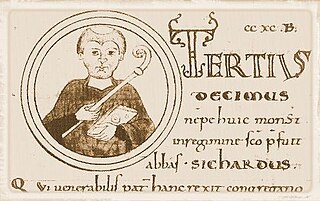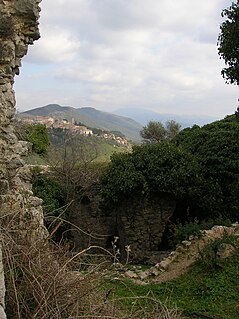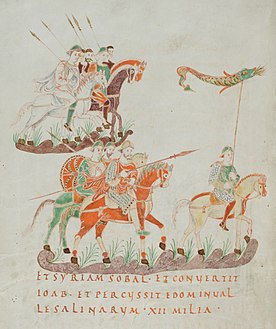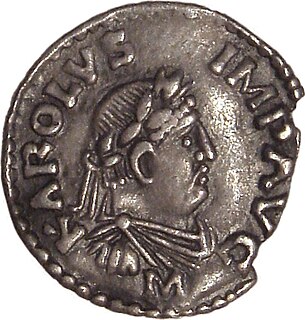
Aistulf was the Duke of Friuli from 744, King of Lombards from 749, and Duke of Spoleto from 751. His father was the Duke Pemmo.

Farfa Abbey is a territorial abbey in northern Lazio, central Italy. It is one of the most famous abbeys of Europe. It belongs to the Benedictine Order and is located about 60 km from Rome, in the commune of Fara Sabina, of which it is also a hamlet.
Ariulf was the second Duke of Spoleto from 592 to his own death.
Transamund II was the Lombard Duke of Spoleto from 724 to 745, though he was twice driven from power by the king, Liutprand. Transamund rose to power by deposing his own father, Faroald II, and tonsuring him in a monastery.
Agiprand was briefly the Duke of Spoleto between 742 and 744.
Unulf was possible a Duke of Spoleto briefly in 752. He is recorded to have reigned for a few years, but this is uncertain. Aistulf, the king, took the duchy into his hands sometime after the death of Lupus.
Gisulf was the Duke of Spoleto from 759 to 761.
Theobald II was the Duke of Spoleto and Margrave of Camerino from 953. He was the son of Boniface II of Spoleto and Waldrada. He married a woman also named Waldrada and was the father of Adalbert, Count of Bologna, and possibly of Willa, the wife of Tedald of Canossa.

Sichard was a 9th century Italian Monk. He was the Abbot of Farfa from c.830 to 842. His abbacy corresponds with a drop in the number of property transactions involving Farfa, perhaps because "[its] wealth was by that time sufficient to cover major building at the abbey itself." Sichard added an oratory to the existing abbey.
Guicpert or Wigbert was the Abbot of Farfa for eleven months in 769–70 and probably also the Bishop of Rieti in 778. According to the twelfth-century chronicler of the abbey, Gregory of Catino, Wigbert was an Englishman and already a bishop when he convinced the dying Abbot Alan of Farfa to name him as his successor. From a twelfth-century perspective, Wigbert's accession was invalid because it was not in accordance with the Rule of Saint Benedict, although that rule was neither strictly nor uniformly enforced at Farfa in the eighth century. Nevertheless, the monks found Wigbert's rule a "tyranny" and sought the king, Desiderius, to remove him and confirm their freedom to elect a successor, which he did.
Aunepert was the second Abbot of Farfa, holding office from the death of the monastery's founder, Thomas of Maurienne, until his own death a few years later. Little is known of Aunepert save that he was from Toulouse, then in the Merovingian kingdom of Aquitaine. By 724 he had been succeeded as abbot by Lucerius when Duke Transamund II of Spoleto granted "a church and its lands" to Farfa.
Lucerius was the third Abbot of Farfa, succeeding Aunepert in 724 at the latest. He was originally from Provence and had been raised at Farfa by Thomas of Maurienne, the first abbot. Lucerius' abbacy was a period of growth and expansion on the part of the abbey. In his first year, he received a grant of a church with its (unspecified) lands from Duke Thrasimund II of Spoleto. This church, dedicated to Saint Getulius, lay within the jurisdiction of the Diocese of Rieti, and according to the tenth-century Exceptio Relationum Thrasimund had to compensate the bishop for his loss.
Hilderic was the fifteenth Abbot of Farfa from 844. In 842 Abbot Sichard died, and the Emperor Lothair I (840–55) intervened to appoint Bishop Peter II of Spoleto in control of the abbey in the interim. Peter organised an election, in which the monks chose Hilderic, and convinced Lothair to confirm him in the abbacy in 844. From his death in 857 the history of the abbey falls into relative obscurity until about 920. The anonymous Libellus constructionis Farfensis, which in its original form was composed in the late ninth century, relates the history of Farfa from its foundation by Thomas of Maurienne down to the death of Hilderic.
Altpert was the Abbot of Farfa from the death of Ragambald in 786 until his own death a few years later. He was described by Gregory of Catino, writing some three centuries later, as having been born in Paris "of the Gauls" (Galliarum), presumably meaning that he was a Romance-speaking subject of the Carolingians. He increased the patronage of the abbey compared to his predecessor, but Farfa was still less successful in seeking out grants and donations than it had been under the local abbot Probatus. Altpert received a donation of lands at Rabenno from Duke Hildeprand of Spoleto, two other donations and one oblation.

Fulcoald was the fourth Abbot of Farfa from 740. In 739 King Liutprand granted Farfa the right of freedom in abbatial elections, but we do not know if Fulcoald was the product of such a free election or not. Like his predecessor, Lucerius, Fulcoald hailed from Aquitaine, then in southern Francia. "With his abbacy, the quantity of our [historical] evidence dramatically increases [and d]evelopments in secular politics can now be seen to impinge on Farfa's land acquisitions." Fulcoald's abbacy can therefore be defined in terms of three objectives that are apparent in the surviving sources: (a) to extend its landholdings and secure its rights to its properties, (b) to promote a strict and disciplined monastic observance, and (c) to "steer as untroubled a course as possible through the choppy waters of Italian politics".

Alan was an Aquitanian scholar, hermit and homilist who served as the sixth Abbot of Farfa in central Italy from 761. Before taking over at Farfa, Alan composed the Homiliarium Alani, "one of the most successful homiliaries of the late eighth and early ninth centuries", traces of which may be found in the liturgical formulae scattered throughout Farfa's eighth-century charters.
Perto was the Abbot of Farfa from 854/7 to 872. Between 857 and 859 he received a privilege from the Emperor Louis II confirming a cella called Santa Maria del Mignone. Since this is the first time Santa Maria is mentioned in Farfa's possession it may have been acquired around this time by Perto. Louis's diploma confirmed privileges granted Farfa by his father, Lothair I, in 840. The imperial diploma forbade any financial imposition on Farfa by any pope or secular ruler. This diploma may have been aimed at courting good relations with the pope or it may be associated with Louis's intervention in the Duchy of Spoleto in 860. In 864 Louis confirmed Farfa's possessions and, at the insistence of Bishop Peter of Spoleto, protector of the abbey since 840, made a donation to it in the region of Massa Torana.
Probatus was the Abbot of Farfa from 770 until 781, and the first abbot native to the Sabina. He steered the abbey through the fall of the Kingdom of the Lombards, trying to prevent the disastrous aggression of its last king, and kept it from falling under the jurisdiction of either the Papacy or the Papal States. With the benefit of his local connections he oversaw a great expansion of the abbey's properties through grants and purchases, and also rationalised its holdings to create a robust base for an early medieval monastic community.

Gregory of Catino was a monk of the Abbey of Farfa and "one of the most accomplished monastic historians of his age." Gregory died shortly after 1130, possibly in 1133.
Sarlio was the Duke of Spoleto from 940 until 943. He was originally from Provence and served as a count of the palace under King Hugh.








